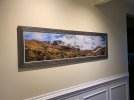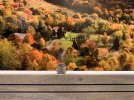A few questions:
Are you shooting in Manual mode for photos and video or auto?
What shutter speed are you using for your photos?
Are you using the AEB (bracketing) for your photos?
" " " the d-cinelike color profile?
" " " Adobe Lightroom for editing your photos?
Did you previously shoot a lot of video with your Canon Mirrorless or mostly a still photographer?
Your photos look contrasty and over-saturated. Crushed blacks, blown highlights.
What's apparent from your video starting at 00:09 is... if you're shooting video at 24 or 30fps, the shutter speed is not set properly to 1/50 or 1/60 respectively. That's why your video looks jittery, particularly noticeable when you added the speed ramping. Get some variable ND filters and set your frame rate and shutter speed properly for natural motion. ND filters are critical when shooting video with a fixed aperture camera, but of course I need them on my
M2P as well (with aperture control). When you've set it properly, you'll notice the bottom of the frame will have a natural motion blur, not a jittery fast shutter video look.
You were smart to mostly fly straight and use POI's in the beginning, but I was waiting for the inevitable, where you start to use the gimbal at 1:30. No control. You need to go into the advanced settings and greatly reduce your yaw speed and gimbal pitch speed and smoothness for both. Reduce yaw speed to the lowest to start out. I've found no need to turn fast and even at low yaw speed, it requires a very light touch to achieve a gentle turn. The gimbal speed should be pretty slow as well for the
MA2, smoothness is dependent on your ability to do manage 3-input control for complicated combination cinematic moves.
Spotlight and POI provides some of the best and easiest moves with visual parallax and allows you to control elevation changes, pull away and boomerang type shots while maintaining your focal point.
The gimbal is your key to dramatic shots with less effort, but you'll need to manage multiple inputs. Your opening shot traveling low over the water starts out good, but as you descend, you need to tilt gimbal up maintaining the axis from the center point of rotation. Same applies to the gimbal tilt down... progressively slow your forward/backward speed and increase elevation as you tilt gimbal down over a feature, both of which help to maintain the axial relationship. You'll need to slow your forward movement to a crawl as you come over your feature or you'll pass over it while it's still in motion blur. Then descend as you tilt gimbal back up to continue your travel. You can do this a couple/few times in a long segment over a rocky shoreline or mountain ridge, but don't overdo the move.
My last point is that you really have to decide before launching whether you're shooting photos or video. Realistically, you can't have it both ways. 1/50 shutter speed is not good for shooting still images from a flying object that's unstable even with a gimbal. Just like DSLR/Mirrorless photography, slower shutter speeds will result in unsharp images even on a tripod. If your intention is to shoot photos, use a polarizing filter or clear and shoot the lowest ISO, fastest shutter speed you can using AEB so you have 3-5 images from which to choose or mask for the final image.














